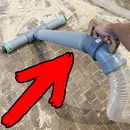Introduction: 360° Work Light
A construction site needs good lighting - that is a fact. Lack of it can cause poor work quality or worse yet - accidents. That´s why it is such a good idea to build a simple 360-degree lighthouse work light and all that on the cheap!
The idea of this build had been on my mind for a long time. I think I saw something similar at my local Men´s shed but I was also inspired by Makita´s area work light. Though, let´s be honest - not many of us have over 300+€/$ to spend on a light! Instead, why not spend an evening and around 50€ to build a DIY 360° work light tailored to your specific needs!?
This instructable will show you how I did it! Let me know in the comments if you have any ideas to improve this design. This will certainly not be the last 360° work light that I build. More about that in the final step.
I am currently renovating my own homestead. The photos are taken inside the WC that I am currently tiling. If you are interested in seeing my progress or any other projects I build I invite you to follow me on Instagram! Thanks!
Watch the short build video here⬇️ or find the reel on Instagram!
Supplies
Building a work light is nothing complicated. Only a power cord and a lamp is needed to make it work. Everything else is just cool features. I decided to add a regular switch along with a motion sensor switch as I like to conserve energy. I can place the light in my shed for example and when I go to quickly grap something I have an automated light. Another feature is a power outlet in case I need to use the light as an extension cord or use power tools near it.
Materials needed:
- 4X LED light bar 1700 lumen/18 watts (Mine are around 60 cm long and cost something like 6€ at my local building supply store)
- 1X LED plafon 710 lumens/8 watts (15 cm in diameter and 8€)
- Surface-mounted double switch (3€)
- Motion sensor switch (10€)
- Surface-mounted small electrical box (leftover from other projects - 2€)
- Surface-mounted double electrical outlet (leftover - 5€)
- Extension cord (5 meters long and 8€)
- Quick connectors (2x)
- wood screws
- Wire
- Scrap plywood 12mm and 21mm (roughly 350x1000mm and 200x400mm
- Wood glue, nails, and screws
Tools needed:
- Circular saw and band/jig saw to cut plywood
- Cordless drill to drill holes and install hardware
- Wire cutters and strippers
- Soldering iron
Please bare in mind that I am not an electrician! I am just a guy who invents and likes to figure stuff out. As you can see in later steps I made some mistakes while wiring. Please ask someone to help you do the wiring if you are not absolutely sure of what you are doing. :)
Step 1: The Plywood
I started the project by cutting 12mm plywood into four pieces - these would make up the body of the light. As the light bars were 80mm wide in my case, the plywood would be the same width. I like to do rabbet joints when assembling plywood boxes and I did the same here. It adds a bit of strength but mainly helps with alignment when assembling the box. I cut the rabbet using my table saw but a router would have been a better option.
The box was assembled using wood glue and small nails.
Step 2: The Legs
I figured as this is just a prototype it does not make much sense to build some fancy folding legs. I decided to go with simple cross legs made of 21mm plywood. I first cut two pieces of roughly 100x400 mm. As the cross-halving joint would be much easier to cut before the final shape of the legs I did that next. It was done on a table saw cross-cut sled. The final curved shape can be given using a band saw or a jig saw. Nothing specific - just what seems right. The cross was assembled with two screws both top and bottom. It seemed enough for the task at hand.
To connect the legs to the mast I did cut a joint as shown in the photos. This is easy to do on a table saw but also bit sketchy so do not attempt it if you are unsure what you are doing! The legs were once again screwed to the mast using four screws.
As there was some unevenness in the legs I ended up adding a furniture bolt to each leg. This allowed some adjustment heightwise and made the contact surface to the floor much stronger.
Step 3: Installing Hardware
Installing all the hardware was pretty straightforward. The socket and the switches were attached to the top of the mast using screws. Only the motion sensor was recessed. I think I could have gotten away without the small electrical box as there is enough room inside the mast. The light bars have special clips for attaching them. These are not the strongest and that is the reason I added tape around the mast top and bottom to make sure the lights would not come loose.
Step 4: The Dome
Well, it would have been a waste of potential lumens if there was not a LED plafon on top of the mast. They come in many different sizes but I chose a pretty small one. To attach it I cut out a circle from 12 mm plywood. I made the circle slightly bigger than the light itself as it would protect the light when the whole tower falls over. I used a washer to trace an outline slightly bigger than the plafon. A square from 21 mm plywood was glued and nailed to the bottom of the circle so it could be firmly attached to the mast. A small hole for the wire was made and the plafon was attached to the plywood. Two screws through the side of the mast and the thing would not be going anywhere.
Step 5: The Wiring
The main cable that powers the light was not the thickest but the package said it can handle up to 3500 watts. I first wired the socket as this would draw the most power when I plug a tool into it. After that, I moved down to 0.8mm^2 as all the lights combined would draw only 80 watts. Thinner wire is also significantly easier to work with. I connected a ground wire only to the socket as these LEDs do not have a place for it anyway.
I really like motion sensors and that's why I included it in this light as well. Of course, there is also a regular ON-OFF switch in case I am working and need constant light. That's why there is a double switch.
The power cable was secured to the bottom of the mast using a single pan-head screw and a couple of zip ties. This assured the connections would not get damaged if the cable was ever yanked.
This setup has a few IP55 components meaning it could also be used outside but I would not risk it. The lights themselves are IP20 I think and suitable only for indoor use. For that reason, I did not bother finishing the plywood parts either. It is a prototype after all!
Step 6: Setbacks
Well, it was not all fun and games building this lamp. It would have taken me only one evening to build it but as the LED bars were really poor quality I did have to resolder some connections. Installing the lights I did manage to yank the power cable loose in some instances and ended up soldering a longer cable in instead.
I did also manage to fry the motion sensor. Although I had previously wired several similar sensors I did mix up two wires and blew the circuit completely. A trip to the store was in order. Wiring the new one I made sure I got everything right.
The sensor also has some adjustment screws for the timer and LUX( how dork it has to be for it to work)
Step 7: The End
That's it! I hope I have inspired you to build your own work light. Please share photos with me if you do so!
Building this light I did come up with several ways to improve. For example:
- Battery powered version
- Using LED strips instead of store-bought bars to get even more lumens per watt
- Heavy-duty and waterproof version.
- Foldable legs or weeble wobble foot like the one on the Makita version
- A way to hang it from the ceiling
- Dimmable LED-s
Do you have any improvements in mind? I would love to hear them!
If you are interested to see my homestead renovation or my other numerous project be sure to follow me on Instagram.
Thanks for tuning in!
Cheers
Andu

Second Prize in the
Lamps Challenge













